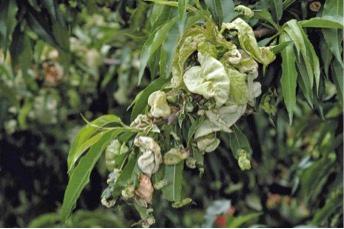Peach Leaf Curl
-
AboutFungal disease that affects the blossoms, fruit, leaves, and shoots of peaches, ornamental flowering peaches, and nectarines. One of the most common disease problems for backyard gardeners growing these trees. When severe, the disease can reduce fruit production substantially. The loss of leaves and the production of a second set result in decreased tree growth and fruit production. Defoliation in spring may expose branches to sunburn injury. If leaf curl infection builds up and is left uncontrolled for several years, the tree may decline and need to be removed.
 Photo: UC ANR
Photo: UC ANR -
Category
-
Fungi
-
-
Signs/Symptoms
First appears in spring as reddish areas on developing leaves. Areas become thickened and puckered, causing leaves to curl and severely distort.
Thickened areas turn yellowish and then grayish white, as velvety spores are produced on the surface by the leaf curl fungus.
Later affected leaves turn yellow or brown and can remain on the tree or may fall off; they are replaced by a second set of leaves that develop more normally unless wet weather continues.
Infects young green twigs and shoots. Affected shoots become thickened, stunted, distorted, and often die. Only rarely do reddish, wrinkled to distorted (or hypertrophied) areas develop on fruit surfaces. Later in the season these infected areas of fruit become corky and tend to crack.
-
Where
On developing leaves, young green twigs and shoots, fruit.
-
When
Symptoms appear about two weeks after leaves emerge from buds. Periods of cool, wet weather are optimal for the disease. Moisture from rain, dew, or irrigation for more than 12.5 hours at temperatures below 61°F is needed for infection. Maximum infection occurs when trees are wet for two or more days. Development stops when young tissue is no longer developing or when weather turns dry and warmer (79° to 87°F).
-
Prevent
Plant varieties that are resistant or partially resistant to leaf curl. Currently available resistant varieties include ‘Frost’, ‘Indian Free’, ‘Muir’, and ‘Q-1-8’.
-
Manage
If a tree is severely affected with peach leaf curl this can stunt its growth; consider thinning fruit later in the season. Pruning in fall prior to applying any fungicides can reduce spore numbers overwintering on the tree and reduce the amount of fungicide needed. If leaf curl symptoms occurred in spring, be sure to treat the following fall and/or winter to prevent more serious losses the following year.
Treat with a fungicide just after leaves have fallen, usually late November or December. A second application in late winter before buds swell can be considered, especially in areas with high rainfall or during wet winters.
Safest, effective fungicides available for backyard trees are copper soap (copper octanoate) or copper ammonium, a fixed copper fungicide. Apply either of these.
-
More Information

